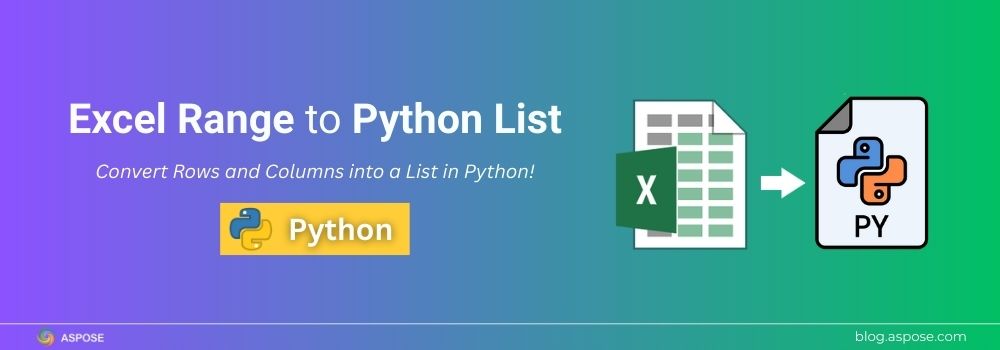Working with Excel data in Python often requires extracting specific rows and columns into a list format. Converting an Excel range to a Python list is extremely useful for tasks like:
- Data analysis with Pandas and NumPy
- Automation of reporting and ETL processes
- Integration with machine learning models or APIs
In this article, we will learn how to convert a defined Excel range to a list in Python step by step.
Python Excel to List Converter Library
Instead of parsing Excel files manually, developers can use Aspose.Cells for Python via .NET, a powerful Excel to List converter library. It not only makes it easier to extract ranges, rows, and columns into Python lists but also supports advanced features such as formulas, formatting, charts, and pivot tables, ensuring accuracy even with complex spreadsheets.
Before coding, make sure your setup is ready:
- Install Python 3.7+.
- Download Aspose.Cells from releases or install it with pip:
pip install aspose-cells-python
- Prepare a sample Excel file (
sample_data.xlsx) with the following content:

Sample Excel Data File.
Convert Excel Range to Python List: Step-by-Step Guide
Let’s go through the process of converting a range of Excel data into a Python list using Aspose.Cells for Python.
Follow the steps below to convert an Excel range to a list in Python:
- First, load the existing Excel file using the
Workbookclass. - Second, fetch the first worksheet.
- Next, create a range, e.g., A1 to C4.
- After that, convert Range to a Python List.
- Finally, print the list.
The following Python script loads the Excel file, defines a range, and converts it into a Python list.
Output
Python List Output:
[['City', 'Region', 'Store'], ['Chicago', 'Central', 3055], ['New York', 'East', 3036], ['Detroit', 'Central', 3074]]
This full script shows how to extract data from Excel and convert it into a Python list. After that, it can easily be transformed into Pandas or JSON depending on your requirements.
Convert Python List to Pandas DataFrame
With Pandas, you can directly transform the list into a DataFrame:
import pandas as pd
# Convert to a Pandas DataFrame
df = pd.DataFrame(range_list[1:], columns=range_list[0])
print(df)
Pandas DataFrame Output:
City Region Store
0 Chicago Central 3055
1 New York East 3036
2 Detroit Central 3074
Save Python List as JSON
You can also export the data as JSON:
import json
# Convert to JSON
json_output = json.dumps(range_list)
print(json_output)
JSON Output:
[["City", "Region", "Store"], ["Chicago", "Central", 3055], ["New York", "East", 3036], ["Detroit", "Central", 3074]]
Convert Excel Row to List in Python
Sometimes you may want to extract just a single row from Excel and store it as a list. Here’s how to do it with Aspose.Cells:
- Load the Excel workbook.
- Access the target worksheet.
- Select the row by index.
- Collect row values into a Python list.
Output:
Row to List: ['City', 'Region', 'Store']
Convert Excel Column to List in Python
You can also extract a single column into a list. For example, let’s convert the Region column into a list:
- Load the workbook and worksheet.
- Select the column by index.
- Traverse each row in the column.
- Collect column values into a list.
Output:
Column to List: ['City', 'Chicago', 'New York', 'Detroit']
Get a Free License
Evaluate Aspose.Cells for Python via .NET without limits. Request a free temporary license from the license page. Apply it in your code to remove evaluation restrictions. Test every feature, including DF to Excel, charts, formulas, and large files.
Excel to List: Free Resources
Make use of the following resources to deepen your knowledge, strengthen your understanding, and gain practical insights that can help you apply what you learn more effectively.
Conclusion
We demonstrated how to convert Excel data into Python lists by extracting ranges, rows, and columns with Aspose.Cells for Python via .NET. Once in list form, the data can be used for Pandas, JSON, or other processing tasks. While libraries like openpyxl or pandas.read_excel can extract ranges, Aspose.Cells provides more control over formulas, formatting, charts, and merged cells, making it the better choice for complex Excel operations.
If you need help or have any questions, feel free to reach out on our Aspose.Cells Free Support Forum. Our team will be happy to assist you.
